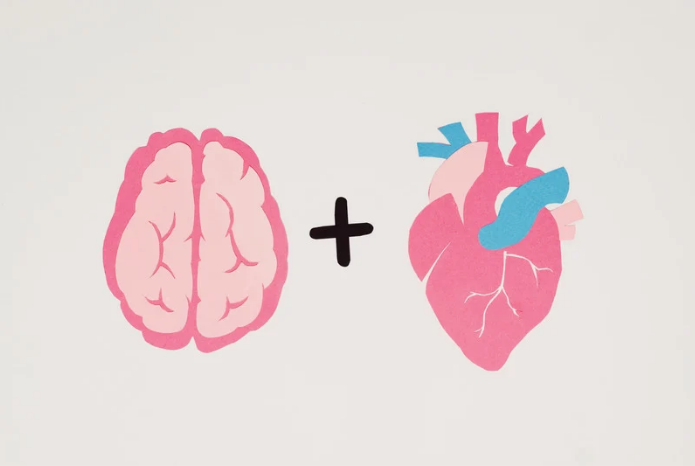Comfort and Joy in the Second Half of Life: Why Whole Brain Living is the Key to Success After 40

Part 1—The Wisdom of Our Two Brains
“But we cannot live the afternoon of life according to the program of life’s morning, for what was great in the morning will be little at evening and what in the morning was true, at evening will have become a lie.” Carl Jung, Modern Man in Search of a Soul
For those of us in the afternoon and evening of life, there are many gifts and challenges. I feel blessed to be married to Carlin for more than forty years. It was the third marriage for both of us and we feel blessed to have between us five wonderful children, plus a bonus daughter. We also have seventeen grandchildren and two great grandchildren.
One of the many challenges we all face as we age is our physical, emotional, and relational health. Truly, we can’t separate what is physical from what is emotional and relational. Carlin and I have had our share of serious challenges. I’ve had an adrenal tumor removed as well as a serious blood clot. She has had heart valve replaced and suffered a mild stroke (if any strokes can be called, mild) following a partial hip-replacement surgery.
In 2008 Harvard trained neuroanatomist, Jill Bolte Taylor, gave a talk, “My Stroke of Insight.” It has now been viewed nearly 30 million times and remains one of the most popular TED talks ever. Within three months of delivering the talk, she was chosen as one of Time magazine’s 100 Most Influential People in the World. She was the premier guest on Oprah’s Soul Series webcast, her memoir, My Stroke of Insight: A Brain Scientist’s Personal Journey, was published by Penguin Books, and it spent 63 weeks on the New York Times bestseller list.
I read Dr. Taylor’s most recent book, Whole Brain Living: The Anatomy of Choice and the Four Characters That Drive Our Life. It was the most important book I had read in years. It not only helped me understand myself and my clients, but it helped me come to terms with Carlin’s stroke and what we needed to understand as we moved more fully into the last period of our lives. I reached out to Dr. Taylor and invited her to do an interview with me.
She explained that we really have two different minds and cited the work of Harvard psychiatrist Fredric Schiffer, author of the book, Of Two Minds: The Revolutionary Science of Dual-Brain Psychology.
“From my early days as a psychiatric resident,” says Dr. Schiffer, “I noticed that my patients often seemed to have a kind of double personality. On the one hand part of them was very mature and stable, but on the other hand, another side of them seemed to be more irrational, overly emotional, and impulsive.”
Dr. Shiffer goes on to say,
“The troubled part seemed usually to still be stuck in a traumatic past, and I had begun to see the object of treatment as helping this distressed part learn that it was more valuable and safer than it had believed based on past experiences.”
Dr. Taylor also described the work of Iain McGilchrist, a psychiatrist, writer, and former Oxford literary scholar. In his monumental work, The Master and His Emissary: The Divided Brain and the Making of the Modern World. Dr. McGilchrist argues that the evidence shows the right and left hemispheres actually amount to two brains.
Contrary to popular beliefs that the left and right hemispheres perform different functions (i.e. left brain, logical and right brain, emotional), Dr. McGilchrist demonstrates that the right and left brains perform the same basic functions, but in very different ways.
“The two hemispheres have styles — takes, if you like, on the world,”
says McGilchrist.
“They see things differently. They prioritize different things. They have different values.”
He goes on to say,
“The left hemisphere’s goal is to enable us to manipulate things, whereas the goal of the right hemisphere is to relate to things and understand them as a whole. These two ways of thinking are both needed but are, fundamentally at the same time, incompatible.”
Dr. McGilchrist believes that how we interpret and experience the world depends on whether those two brains are working in balance, or whether one is dominant or damaged. That, in turn, shapes the world we live in. Evidence shows we are increasingly living in a world that is out of balance and dominated by left hemisphere thinking.
“This way of thinking which is reductive and mechanistic has taken us over,”
says McGilchrist.
“We behave like people who have right hemisphere damage that treats the world as a simple resource to be exploited. It’s made us enormously powerful. It’s enabled us to become wealthy, but it’s also meant that we’ve lost the means to understand the world, to make sense of it, to feel satisfaction and fulfilment through our place in the world.”
Our current collective brain imbalance is leading humanity to disaster.
“The left brain pays sharply focused attention to detail and sorts and organizes people and things into neat, orderly categories,”
says McGilchrist.
“The left brain doesn’t understand relationships. It’s the right brain that understands context and the big picture–our relationships with others and how we fit into a complex, non-linear world in which everything is connected.”
He quotes Einstein who said that
“the rational mind is a faithful servant, but the intuitive mind is a precious gift, and we live in a world that has honored the servant but has forgotten the gift.”
In other words, Dr. McGilchrist sees that we have lost our way.
“We behave like people who have right hemisphere damage.”
He goes on to say,
“the right hemisphere tends to ground experience; the left hemisphere then works on it to clarify, ‘unpack,’ and generally render the implicit, explicit; and the right hemisphere finally reintegrates what the left hemisphere has produced with its own understanding.”
But things go wrong in two ways. First, when the two hemispheres don’t integrate their two ways of seeing the world. Second, when the left hemisphere becomes dominant and fails to recognize its proper subordinate role. Dr. McGilchrist describes what happens as follows:
“In terms of the metaphor of the Master and his emissary, the Master realizes the need for an emissary to do certain work on his behalf (which he, the Master, must not involve himself with). The emissary, however, knowing less than the Master, thinks he knows everything and considers himself the real Master, thus failing to carry out his duty to report back. The right hemisphere’s view is inclusive, ‘both/and’ synthetic, integrative; it realizes the need for both. The left hemisphere’s view is exclusive, ‘either/or’ analytic and fragmentary—but, crucially, unaware of what it is missing. It therefore thinks it can go it alone.”
This is a like the adolescent thinking they know more than the parent or the young man who thinks his father is old-fashioned and knows nothing about the real world. Just as elder wisdom is needed to have a successful life in the second half, we need re-establish the proper balance between left and right brain if humanity is to survive.
In the second part, we will talk about how the two halves of the brain can become reintegrated and how the four brain characters can guide our lives in mid-life and beyond and at this time in human history where elder wisdom is needed now more than ever.
Your comments are welcome. Please subscribe to my free weekly newsletter and read more articles about living and loving in today’s world.







